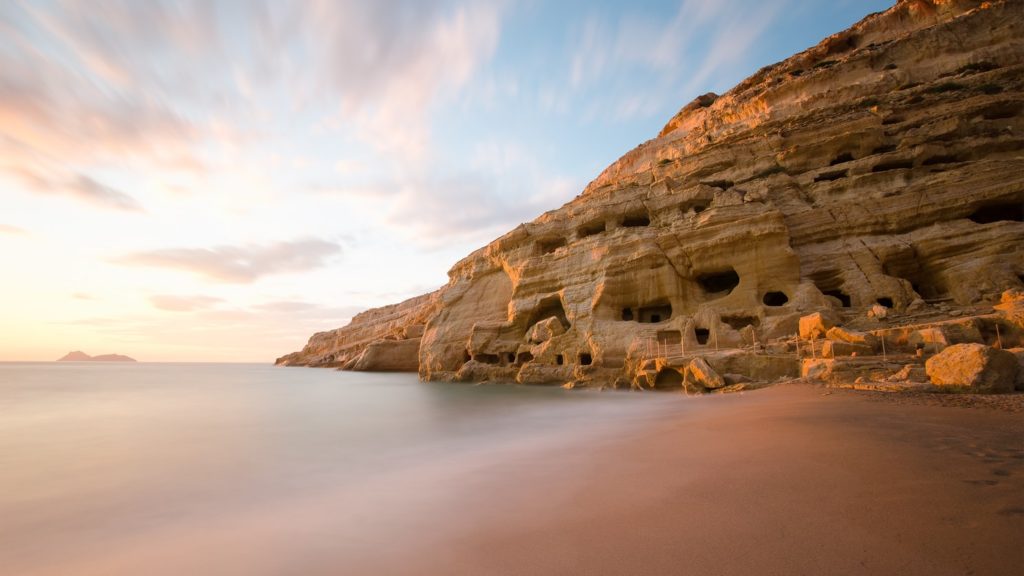Destination Crete
Whatever brings you to 3 Pines Design Living, a leisurely vacation, or a business trip, there are countless opportunities for exploration, recreation, and taking a generous dose of local culture and history in Heraklion and the island of Crete.

Chania
Chania, the second largest city of Crete, is marked by different civilizations that flourished in the past, leaving behind magnificent monuments and a colorful Old Town. Chania is perfect for a day trip during your stay at 3 Pines. Stroll around the Old Town’s alleys and wander around the Old Port. Discover the iconic Egyptian lighthouse, the Yali Mosque, the renovated Grand Arsenal, and the Kum Kapi. See the beautiful Venetian mansions, the fountains, and churches, and then visit the aristocratic Halepa district to admire its neoclassical buildings. The buzzing port and the Old Town of Chania are teeming with lively cafés and restaurants, where tourists mix with the locals.

Rethymno
Rethymno is a charming town, just about an hour's drive from 3 Pines. The Οld Τown of Rethymno preserves its Renaissance glory and is a time machine that takes you back to the era of the Venetian rule in Crete. Buildings and monuments like the Neratze mosque from the Ottoman era stand next to beautiful Venetian monuments like the Loggia and the Priuli fountain. Rethymno's most significant landmark is Fortezza, a hilltop Venetian fortress. Explore the narrow alleys of the Οld Τown, visit the picturesque Venetian harbour with the old lighthouse and take a break at Rethymno’s vivid cafés and rakadika, where locals enjoy the traditional raki with some mezze. For more nightlife opportunities, head to the coastal road of Rethymno and the area of the Venetian port.

Agios Nikolaos
Agios Nikolaos is the main town in the Lassithi region and a cosmopolitan destination that attracts thousands of visitors each summer. The centre of Agios Nikolaos is dominated by lake Voulismeni, where, as the myth goes, goddess Athena and goddess Artemis used to bathe. Agios Nikolaos’ coastal road and scenic pedestrian streets are perfect for leisurely walks and shopping. The town offers buzzing cafés, traditional taverns, fancy restaurants, and vivid cocktail bars. If you want to have a swim, Kitroplatia is an organized town beach about 200 m. from the lake. The wider area of Agios Nikolaos offers numerous beaches with crystal clear waters and water sports facilities.

Elounda
Elounda is a popular cosmopolitan resort situated in the ravishing Gulf of Mirabello. What used to be a small fishing village is now a lively town in the wider area of which some of the most luxurious hotels and resorts of Crete are gathered. Taking a boat to Spinalonga is a “must-do”. This islet that guards the entrance of the gulf of Elounda, is nominated as a UNESCO World Heritage Site, and has a long and interesting history that inspired Victoria Hislop’s best-seller “The Island”. The Venetians built on Spinalonga a bastion-type sea fortress. Later, during the Ottoman era, it was settled by Muslims. Today it is mostly known as the site for the leper colony of Crete during the early 20th century. From Elounda, it is also worth visiting the small fishing village of Plaka.

Phaistos
The Minoan palace of Phaistos which lies on a hill at Messara plain is considered to be the second most important Minoan site after Knossos and perhaps the finest of all Minoan palaces. It was built at the beginning of the 2nd millennium B.C., it was destroyed by fire in 1700 B.C. and a new palace was built on its ruins. The ruins of the old and new palaces are preserved today. As you wander around the archaeological site you will see storerooms, workshops and shrines, the royal quarters, a theatral area, and the temple of Rhea which was built in the Archaic period. The finds from the palace, the most famous of which is the Disc of Phaistos, are now exhibited in the Archaeological Museum of Heraklion.

Matala
Matala is a popular tourist destination on the south coast of Crete, at the bay of Messara. At the beginning of the 20th century, it was a small fishing village, and then came the hippies! During the 60s and 70s, hippies from all over the world settled in Matala and occupied the artificial caves in the cliff that rises at the north side of the bay. The famous Matala caves were carved on the limestone rock during the Neolithic Age and they were probably used as tombs or living spaces in antiquity. Joni Mitchel was among the Flower Children that settled in Matala. Today Matala is a lively touristic village, with restaurants and bars overlooking the beautiful bay. The adjacent Komos beach is also worth a visit.


